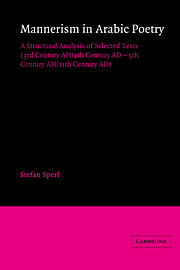 Mannerism in Arabic Poetry
Mannerism in Arabic Poetry Summary
The themes of the zuhdiyya canon are frequent in Arabic literature. One of the works based on them is the corpus of poems entitled Luzūm mā la yalzam by Abū l-‘Ala’ al-Ma‘arrī. It centres on the traditional principles of zuhd poetry but encompasses a wider range than the zuhdiyyāt of Abū l ‘Atāhiya. Unlike the latter, the Luzūmiyyāt are ‘learned poetry’ and include references and allusions to many facets of culture. They evolve an idiosyncratic moral code so that the meaning of zuhd is changed; it is an intellectual creed remote from the simple asceticism of the earlier model. The following quatrain provides a first illustration (Ma‘arrī, 1892, vol. I, p. 227):
iqni‘ bi-mā raḍiya l-taqiyyu H-nafsihī
wa-abāḥahu laka fi l-ḥayāti mubīḥū
mir‘ātu ‘aqlika in ra’;ayta bi-hā siwā
mā fī ḥijāka arathu wa-huwa qabīḥū
asnā fi‘dāika mā aradta bi-fi‘lihī
rashadam wa-khayru kalāmika l-tasbīḥū
inna l-ḥawāditha mā tazālu lahā mudan
ḥamalu l-nujūmi bi-ba‘ḍihinna dhabīḥū
Be satisfied with the pious man's choice –
life's lawmaker has made it lawful to you.
If in your reason's mirror you perceive what disagrees
with your conscience you will discern it as evil.
Your most exalted deeds are those in search of righteousness;
your greatest words are those in praise of God.
Fate's vicissitudes remain endowed with knives;
the ram of heaven shall be their slaughter victim [too].
Lines 1 and 3, referring to the actions of the addressee, propound the traditional maxims of piety (tuqā).The remaining two lines, however, penetrate the sphere of reflection and imagination in an altogether different manner.
The theme of the pious man's contentment with little, expressed in line 1, is familiar from text IV:
- Type
- Chapter
- Information
- Mannerism in Arabic PoetryA Structural Analysis of Selected Texts (3rd Century AH/9th Century AD – 5th Century AH/11th Century AD), pp. 97 - 154Publisher: Cambridge University PressPrint publication year: 1989
